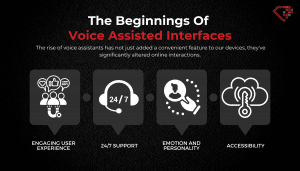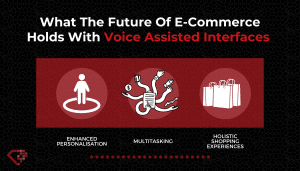With technology rapidly reshaping our daily lives, voice assisted interfaces have emerged as one of the most innovative game-changers. These interfaces, driven by sophisticated algorithms and intricate sound-recognition capabilities, were originally developed to simplify the user experience, offering hands-free, instantaneous responses to our queries.
Think of those moments when you’ve asked your smartphone about the weather or sought a recipe through a smart speaker – those are voice assisted interfaces at work!
Looking to the future though, the scope of voice interfaces has grown beyond mere informational tasks. The e-commerce landscape, a dynamic and ever-evolving sector, hasn’t remained untouched. Voice search in e-commerce, once a novel concept, has now started becoming the norm.
It’s not just about browsing informational sites anymore. Today, an increasing number of e-commerce interfaces are seamlessly integrating voice functionalities, transforming the way we shop online. In this post, we’ll look at where they come from, how they work, and how South African e-commerce brands can take advantage.
The Beginnings of Voice Assisted Interfaces:
Voice user interfaces (VUIs) have transformed the way we communicate with our gadgets. VUIs allow us to engage with digital systems using voice or speech commands. While many of us are familiar with renowned virtual assistants like Siri, Google Assistant, and Alexa, the journey of voice interfaces goes deeper into the past than you might expect.
The groundwork for VUIs can be traced back to 1984 with the advent of IVR (Interactive Voice Response) systems, but a monumental leap occurred in 1976. Dr. Bruce T. Lowerre from Carnegie Mellon University introduced the world to “The HARPY Speech Recognition System,” an innovative system capable of deciphering over 1,000 words – a clear harbinger of things to come in the world of voice recognition.
Fast forward to today, when the rise of voice assistants has not just added a convenient feature to our devices, they’ve significantly altered online interactions. These tools serve as powerful web interfaces, ushering users into the digital realm, facilitated by tech giants.
And it’s not just about convenience. VUIs have brought forth many other benefits, including:
- Engaging User Experience: VUIs offer a more interactive engagement with users.
- 24/7 Support: They facilitate constant support without the typical overheads.
- Emotion and Personality: Voices convey emotion, fostering a deeper connection with users.
- Accessibility: VUIs present a lifeline for those with visual and motor impairments, paving the way for more inclusive assistive technologies.
Given all this potential, it’s hardly surprising that voice-assisted interfaces have started influencing the e-commerce sphere.

Integrating Voice-Assisted Interfaces into the E-Commerce World
As e-commerce continues to experience significant growth, the integration of voice interfaces is reshaping the online shopping landscape. No longer restricted to just typing and tapping, shoppers can now command their wishes aloud, introducing a whole new dimension of interactivity.
Businesses quickly realised the potential of VUIs in enhancing product presentation. Products can now be described, highlighted, or even searched for using voice commands. Major e-commerce players like Amazon have introduced voice search functionalities, making product searches as simple as asking a question.
The outcome of such integration has been overwhelmingly positive. E-commerce sites that have embraced voice technology often see heightened user engagement, increased sales, and a more seamless user journey. For instance, a user might casually inquire, “Find me a pair of red stilettos in size 6,” and the voice interface would swiftly curate a list of relevant products. This not only makes shopping more intuitive but also aligns with the evolving consumer behaviours in the digital age.
Of course, the integration of voice interfaces doesn’t come without its challenges. The language of search has transformed. Searches are no longer limited to short, keyword-specific queries; they’ve become more conversational. Businesses have to adapt to this new paradigm, understanding and optimising for the phrases and questions potential customers might pose. Security and privacy, local preferences, the technology behind voice search, and tailoring your platform for mobile users all need to be considered – which we’ll take a brief look at next:
- Security and Privacy in Voice Interfaces
With the rapid growth of voice search in e-commerce, there’s an increasing concern about the data collection practices of voice interfaces. This stems from the recognition that voice data can reveal more intimate details than users might anticipate. Companies are (understandably) capitalising on voice data for targeted marketing, and there’s always a risk of data breaches.
Thankfully, there are measures being established to bolster user trust and ensure their security. For instance, transparency regarding how voice data is used and collected, and giving users the choice to opt-in or out of certain data collection practices is crucial. Another promising approach is the tandem framework that aims to strike a balance between users’ privacy and security when using voice interfaces.
- Global vs. Local – Voice Interfaces in South Africa
Across the globe, the voice search trend is on an upward trajectory, with significant attention being paid to voice search in ecommerce. In 2018, voice shopping sales in the US valued just $2 billion, but by the end of 2022, that number had soared to $20 billion.
In South Africa, while voice search is on the rise, our adoption rate lags a bit behind international standards. However, with the enthusiasm of Generation Z consumers for voice shopping, and internet and mobile subscriptions on the rise across the continent, there’s significant potential for growth in the region.
- The Significance of Mobile in Voice Search
Most voice searches are conducted on mobile devices, be it users seeking directions or making quick online purchases. This rise in mobile voice search highlights the intertwined relationship between mobile use and voice interfaces. The convenience of smartphones naturally complements the hands-free efficiency of voice search.
Integrated voice assistants like Siri, Google Assistant, and Bixby further enhance this user experience. For e-commerce businesses, this blend of mobile and voice offers both an opportunity and a challenge. The potential is to engage a large user base that favours voice commands on mobile. The challenge is ensuring their platforms are optimised for mobile voice search.
In terms of e-commerce web development, this means a responsive design, swift loading times, and content that caters to the conversational nature of voice queries. It’s imperative for e-commerce ventures to recognise its crucial role in voice search and optimise accordingly.
- SEO Implications for Voice Search in E-Commerce
Voice searches differ from conventional text searches in a few key ways. While text searches often consist of fragmented keywords, voice searches are conversational and usually framed as full questions or longer phrases. This makes long-tail keywords and question-based content more relevant in the realm of voice search.
Recommendations for Optimising for Voice Searches:
- Focus on Natural Language: Tailor content to answer common questions and integrate conversational phrases that users might voice out.
- Optimise for Local Search: Many voice searches have local intent. Businesses should ensure their location, hours, and other vital details are updated on online directories.
- Use Structured Data: This can help search engines better understand and index your content, making it more likely to be picked up in voice search results.
- The Tech Behind Voice Assisted Interfaces
At the heart of voice-assisted interfaces lies Natural Language Processing (NLP). This branch of artificial intelligence (AI) focuses on the interaction between computers and human language, making it possible for machines to understand, interpret, and respond to human speech.
Ongoing advancements in voice technology are plentiful. Improved voice recognition capabilities are at the forefront, enabling devices to understand a broader array of accents, dialects, and languages.
And, with the rise of machine learning, voice assistants are becoming better at predicting user needs and offering personalised responses. Continuous research in the field also aims at making these systems more context-aware, allowing for more intuitive and seamless interactions.

What the Future of E-Commerce Holds with Voice Assisted Interfaces
Voice interfaces are rapidly becoming the norm, and their inclusion in the e-commerce sector underscores a shift in how consumers shop and engage with brands. From setting up reminders to placing orders, voice has integrated itself into everyday tasks, providing unparalleled ease and efficiency.
As we look towards the future, there are several intriguing developments on the horizon:
- Enhanced Personalisation: With continuous advancements in AI and machine learning, voice assistants will likely offer a more personalised shopping experience, understanding individual preferences and recommending products accordingly.
- Seamless Multitasking: The hands-free, eyes-free advantage of voice will redefine multitasking, enabling users to shop while engaged in other activities, enhancing convenience.
- Holistic Shopping Experiences: Imagine a future where voice assistants can guide a user through a recipe while simultaneously helping them order missing ingredients or even suggest complementary products.
Such changes signify more than just technological advancements. They highlight a transformative user experience, where shopping becomes more intuitive, interactive, and integrated into our daily lives.

In Conclusion
As the digital landscape evolves, so does the manner in which users interact with it. Voice interfaces are poised to be a revolutionary force, reshaping online shopping and providing users with a more engaging, intuitive, and personalised experience.
But as with any significant digital transformation, the transition to voice interfaces demands expertise. This is where Ruby Digital steps in, ready to guide e-commerce businesses through this exciting new frontier, ensuring they’re primed to leverage the full potential of voice technology for an unparalleled customer experience! Find out more here.



